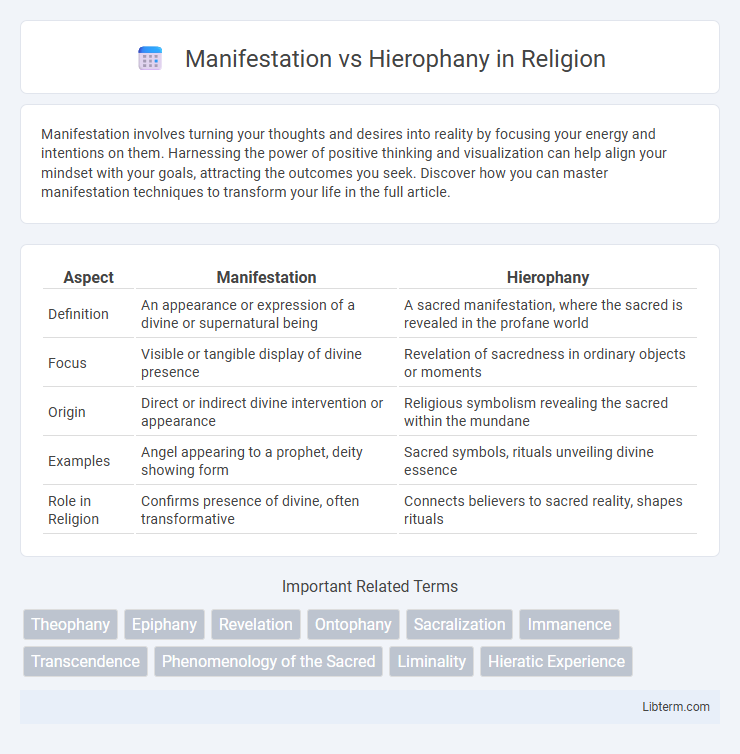Manifestation involves turning your thoughts and desires into reality by focusing your energy and intentions on them. Harnessing the power of positive thinking and visualization can help align your mindset with your goals, attracting the outcomes you seek. Discover how you can master manifestation techniques to transform your life in the full article.
Table of Comparison
| Aspect | Manifestation | Hierophany |
|---|---|---|
| Definition | An appearance or expression of a divine or supernatural being | A sacred manifestation, where the sacred is revealed in the profane world |
| Focus | Visible or tangible display of divine presence | Revelation of sacredness in ordinary objects or moments |
| Origin | Direct or indirect divine intervention or appearance | Religious symbolism revealing the sacred within the mundane |
| Examples | Angel appearing to a prophet, deity showing form | Sacred symbols, rituals unveiling divine essence |
| Role in Religion | Confirms presence of divine, often transformative | Connects believers to sacred reality, shapes rituals |
Understanding Manifestation and Hierophany
Manifestation refers to the process by which the divine or hidden reality becomes visible or perceptible in the material world, revealing deeper truths through symbols or actions. Hierophany specifically denotes a sacred manifestation where the sacred or holy is revealed, often through rituals, artifacts, or natural phenomena that connect the profane with the divine. Understanding manifestation involves recognizing any form of visible expression of the unseen, while hierophany emphasizes the sacred quality and spiritual significance of that revelation.
Defining Manifestation: Meaning and Contexts
Manifestation refers to the tangible or visible expression of an underlying essence, principle, or spiritual reality across various contexts such as philosophy, religion, and mysticism. It denotes the process by which abstract or hidden forces become perceptible in physical or experiential forms, enabling human understanding and interaction. In metaphysical frameworks, manifestation often connects with concepts like divine presence, consciousness projection, or energy materialization, distinguishing it from hierophany, which specifically involves sacred or holy revelations.
Hierophany Explained: Origins and Usage
Hierophany, a term coined by Mircea Eliade, refers to the manifestation of the sacred in the material world, revealing divine presence through symbols, rituals, or sacred objects. This concept originates from ancient religious studies, emphasizing moments when the sacred breaks into ordinary reality, distinguishing it from mere physical manifestation. Hierophany is widely used in mythology, anthropology, and religious studies to analyze how cultures express and experience the sacred.
Historical Perspectives on Divine Manifestation
Historical perspectives on divine manifestation reveal a nuanced understanding of Manifestation as the outward expression of a deity's presence, whereas Hierophany specifically denotes sacred appearances or revelations in tangible forms. Ancient religious traditions, such as those in Mesopotamia and Greece, emphasized Hierophany through sacred objects, temples, or natural phenomena, symbolizing divine interaction with the earthly realm. The distinction between these concepts highlights evolving interpretations of how the divine communicates with humanity across cultures and epochs.
Comparing Manifestation and Hierophany
Manifestation refers to the appearance or revelation of a divine or supernatural entity in a tangible form, emphasizing its physical or visible expression. Hierophany, a term coined by Mircea Eliade, specifically denotes the manifestation of the sacred in ordinary objects or events, highlighting the sacredness embedded within the profane world. Comparing the two, manifestation is a broader concept of divine revelation, while hierophany centers on the sacred's irruption into everyday reality, signifying a qualitative transformation of the ordinary into the sacred.
Manifestation in Spiritual Practices
Manifestation in spiritual practices involves the deliberate process of bringing desires or intentions into reality through focused thought, visualization, and aligned action. It emphasizes the power of consciousness and belief in shaping one's external experience, often supported by meditation, affirmations, and energy work. Unlike hierophany, which reveals the sacred through symbolic appearances, manifestation centers on personal empowerment and the active creation of one's spiritual and material life.
Hierophany in Religious Traditions
Hierophany refers to the manifestation of the sacred or divine in religious traditions, often symbolized through natural phenomena, sacred objects, or ritual acts that reveal the presence of the sacred to believers. Unlike general manifestation, which can denote any appearance or revelation, hierophany specifically denotes the sacred's tangible expression, playing a central role in sacred rituals and mythologies across cultures such as Shamanism, Hinduism, and Christianity. This concept is crucial for understanding how religious believers experience and interpret the divine presence in the material world, linking the sacred to the profane through physical or symbolic means.
Symbolism and Significance of Hierophanies
Hierophany represents the direct manifestation of the sacred in the physical world, symbolizing the intersection between the divine and the mundane through sacred symbols, rituals, or places. Unlike general manifestations, hierophanies carry profound religious and cultural significance, marking moments where the ordinary is transformed into the extraordinary, revealing deeper spiritual truths. This sacred symbolism in hierophanies serves as a pivotal point for communal identity, spiritual insight, and the perpetuation of tradition across generations.
Psychological Aspects of Manifestation
Manifestation involves the psychological process of aligning thoughts, emotions, and beliefs to attract desired outcomes, emphasizing the role of subconscious programming and cognitive reframing in shaping reality. Hierophany, by contrast, denotes the external revelation of sacred meaning or divine presence, impacting psychological states through symbolic experience and spiritual interpretation. Understanding manifestation from a psychological perspective highlights the importance of mindset, intentionality, and self-efficacy in transforming internal cognition into tangible change.
Modern Relevance of Manifestation and Hierophany
Manifestation and hierophany hold significant modern relevance in understanding how the sacred reveals itself in everyday life and cultural expressions. Manifestation refers to the appearing or embodiment of divine presence in physical form or events, influencing contemporary spirituality and mindfulness practices. Hierophany denotes the manifestation of the holy in sacred objects, places, or rituals, shaping modern religious experiences and the architectural design of spiritual spaces worldwide.
Manifestation Infographic

 libterm.com
libterm.com